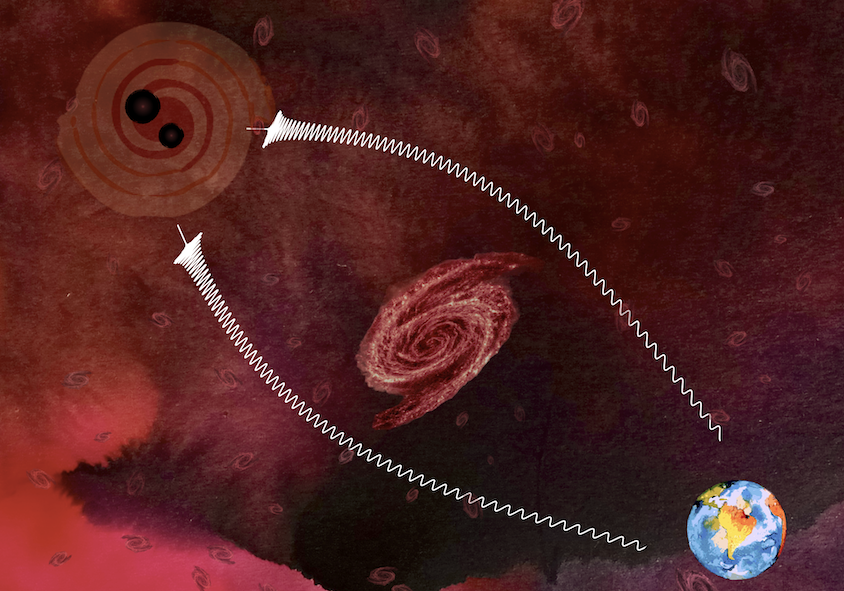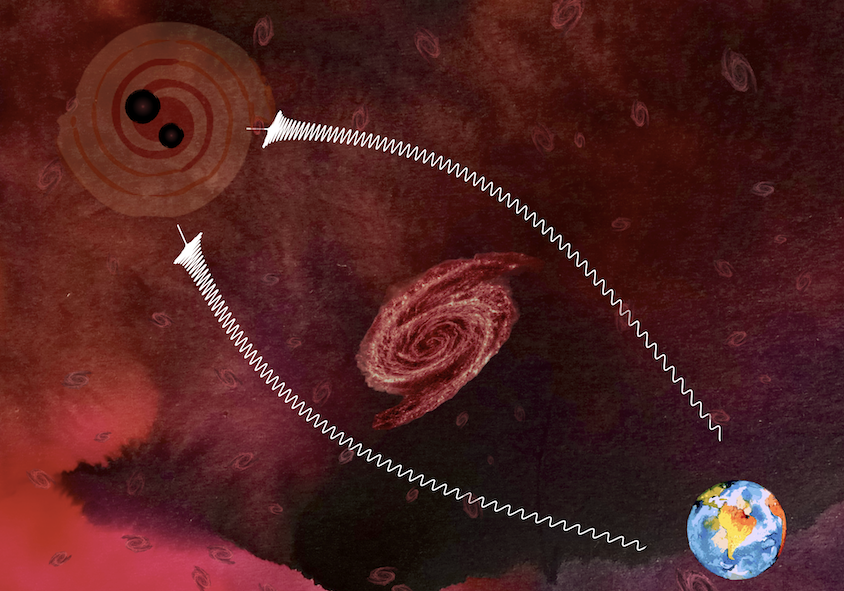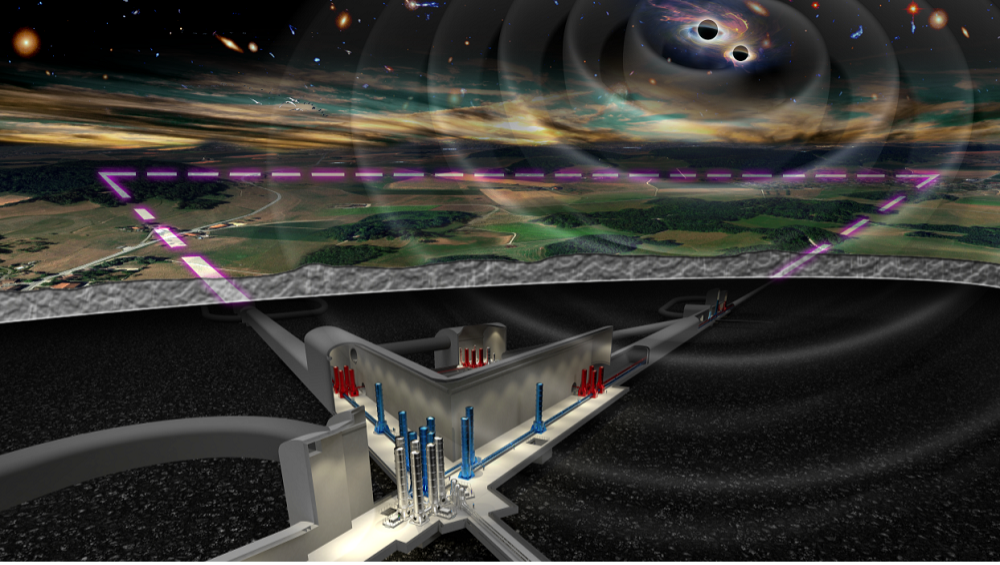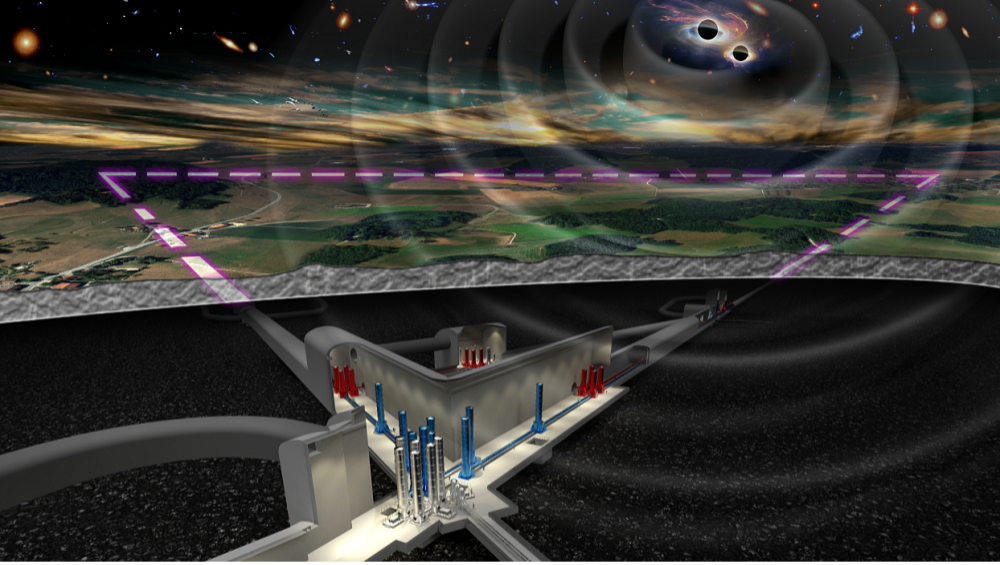Probe of the Cosmos Using Lensed Gravitational Waves
The cosmic expansion rate, defined by the Hubble constant, has become a matter of contention, as different measurement methods give different values. A new method proposes to use gravitational-wave events—specifically those that are “lensed” by an intervening galaxy—to determine the Hubble constant and other cosmological parameters [1]. This statistical approach would require many thousands of gravitational-wave events, so it will only become viable once future gravitational-wave detectors come online. The technique would probe the Universe in an early epoch that lies between the time periods targeted by other methods.
Gravitational lensing is commonly observed for light waves. The most dramatic examples are certain quasars that appear in multiple positions in the sky—their light propagates along several paths around a foreground galaxy. The same bending should occur with gravitational waves, but the effect hasn’t been observed yet. “That will happen in the next few years,” says Parameswaran Ajith from the International Centre for Theoretical Sciences of the Tata Institute of Fundamental Research in India. His confidence comes from the fact that current detectors will soon be cataloging hundreds of gravitational-wave events per year, and at least a few of these events will be located behind a foreground galaxy that will act as a lens.
A lensed event will be detected as two gravitational-wave signals coming from the same part of the sky but with the second one arriving a few minutes to a few weeks after the first. This expected time delay reflects the slight difference in signal path lengths around the foreground galaxy. Researchers have previously considered using time delays in lensed gravitational-wave signals as a cosmological probe [2], but these proposals have assumed that the underlying event is observed both in gravitational waves and in light—a rare occurrence (see Viewpoint: Neutron Star Merger Seen and Heard).
Ajith and his colleagues have devised a new method that does not require a light-based observation; instead, it looks for a cosmological imprint in the statistics of lensed gravitational-wave events. The idea is that the rate of the Universe’s expansion influences where the sources of gravitational events (in particular black hole mergers) are located with respect to the galaxies that serve as lenses. The expansion rate also affects the distances between Earth and the lensed events, which in turn determine the time delays. By assuming a model for the spatial distribution of galaxies, the researchers show that the fraction of gravitational-wave events that are lensed depends on the Hubble constant and on other parameters such as the average matter density of the Universe. They also find that the probability distribution of time delays depends on these cosmological parameters. For example, it turns out that a larger Hubble constant would result in a higher fraction of lensed events and a shift in the time delay distribution to smaller values, compared to the case of a smaller Hubble constant.
However, performing such a statistical analysis will require data on many thousands of gravitational-wave events, which won’t be available anytime soon. The researchers are banking on future detectors, such as the Einstein Telescope—a proposed underground project that is planned for the mid-2030s. This “third generation” of facilities is expected to be 10 times more sensitive than current observatories and may collect as many as 100,000 events per year.
The researchers believe it will be worth the wait, as gravitational-wave lensing offers several advantages over current techniques for studying cosmology. For one, gravitational waves are not affected by the dust and gas that attenuate light waves, so they have the potential to see far into the Universe’s past. In particular, gravitational-wave lensing could offer a measure of cosmic expansion at an early epoch, referred to as “high redshift,” when galaxies were just starting to form. This time period lies between the early and late epochs that correspond to conflicting Hubble constant measurements: the early measurements come from the cosmic microwave background, whereas the late measurements are based on supernova observations.
“The detection of strongly lensed gravitational waves would be a major scientific discovery, which would give observable access to the high-redshift Universe,” says gravitational-wave analyst Jonathan Gair from the Max Planck Institute for Gravitational Physics in Germany. However, he wonders if the long time frame for this statistical approach will make it less competitive with other techniques that are constantly improving. Still, gravitational-wave physicist Chris Van Den Broeck from Utrecht University in the Netherlands thinks this method can potentially have a high impact on cosmological studies because “it adds a completely new measurement method” with different assumptions and uncertainties.
–Michael Schirber
Michael Schirber is a Corresponding Editor for Physics Magazine based in Lyon, France.
References
- S. Jana et al., “Cosmography using strongly lensed gravitational waves from binary black holes,” Phys. Rev. Lett. 130, 261401 (2023).
- K. Liao et al., “Publisher Correction: Precision cosmology from future lensed gravitational wave and electromagnetic signals,” Nat. Commun. 8, 2136 (2017).







